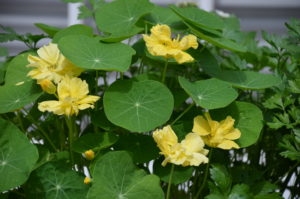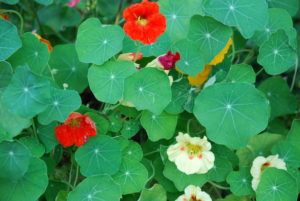Old-fashioned nasturtiums never lose their appeal, whether in the garden or as a garnish on a salad, or added to stir-fries, or favorite pasta dishes. Depending on the variety, some may be grown as climbers on fences and trellises or as bushy plants in a window boxes and containers.
Around the world there are several species of nasturtiums, also called Indian cress. The two most common species grown in U.S. gardens are: Tropaeolum majus , a trailing (climbing) type, and T. minus, a bush (compact) type. Nasturtiums are considered annuals, although they can be herbaceous perennials in southerly climes (zones 8-11).
Nasturtiums flower best in full sun, but prosper in partly shaded locations, particularly where summers are torrid. They love cool, damp, well-drained soil. If plants begin to flag in the heat of summer, cut them back and they’ll regrow and flower again when cooler weather returns in fall.
Nasturtiums thrive on neglect and don’t require rich soil. In fact, if you amend soil with too much nitrogen-rich fertilizer or manure, lots of dark green foliage and few flowers will result. In plain soils, amend the site by mixing in a 1-inch layer of compost. Plants ordinarily don’t need fertilizing during the growing season. Mulching is an added plus.
Nasturtium flowers range from pastels, yellows, oranges, and red shades, in either single or double flowers. Colorful seed mixes are also available. Flowers of most modern day varieties stand above the foliage.
Some of the best selections include:
- Apricot Twist’ (trailing variety) – 3 to 4 feet long and double apricot-orange splashed with raspberry red flowers.
- ‘Empress of India’ (semi-bush variety) – 1 – 2-foot vines and features large, bright scarlet flowers and blue-green foliage.
- ‘Jewel of Africa’ mix (trailing variety) – 4 – 6 foot long in yellow, red, cream, and pink flowers and unique variegated leaves.
- ‘Moonlight’ (trailing variety) – up to 7 feet long and produce unusual, pale yellow flowers.
- ‘Peach Melba’ (heirloom bush variety) – creamy yellow blooms with maroon markings near centers.
- ‘Tip Top’ series – compact ‘Alaska’ series with mottled leaves and bright flowers in yellow, red and orange.
- ‘Tom Thumb’ series – shorter (6-9”) type with large, vivid blooms in bright yellow, red and orange; excellent for small gardens.
- ‘Vesuvius’ – compact plant habit and brilliant deep salmon flowers and deep blue foliage.
- ‘Whirlybird’ series (bush type) – a mix of flower colors, or in separate colors, including cream, salmon, gold, and cherry rose. The flowers are semi-double.
After sowing, keep the bed well-watered and weed-free. Nasturtiums are relatively trouble-free. Aphids may feed on the new leaves and flowers; washed bugs off with frequent sprays of water or use insecticidal soap.
Nasturtiums are high in vitamins A, C (10 times as much as lettuce), and D. Harvest nasturtium young leaves, flower buds and open blooms in early morning; those collected later in the day are more pungent. Wash and dry the flowers and leaves and store in a plastic bag in the refrigerator. Unripe seed pods have a peppery flavor somewhat like watercress and may also be used in salads.



 Posted in
Posted in 
